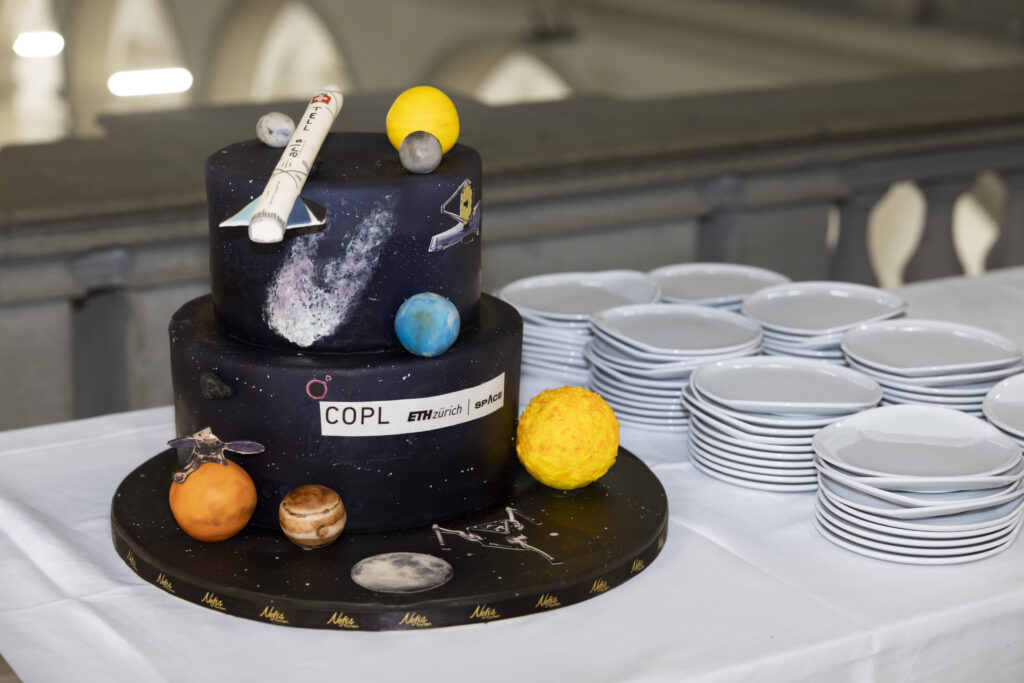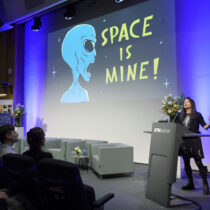Life on Earth and Beyond
April 30, 2024In the wake of the recent ETH Global Lecture: Life on Earth and Beyond, I found myself thinking about the existence of extra-terrestrial life in the universe and the importance of planet socks. It turns out that both can be explained in simple terms. The first goes like this: With all the many, many billions of probable planets outside our solar system, the chances of there being – or that there has been – life on a number of them is high. The question is only: What kind of life?

Thomas Zurbuchen, Swiss-American astrophysicist, ETH Department of Earth Sciences, previously the head of NASA’s science missions, is initially on hand to shed light on the planet socks issue. Newly hired in 2016 as the associate administrator for the science directorate at NASA after an academic career, he found himself in need of clothes that would suit appearances before the US Congress. Wanting to add an interesting accent to his conservative new attire, Zurbuchen knew the right opening: socks that matched his job. Socks with planets on them. Socks he shows off at the lecture.
Also in attendance is the Swiss astronomer and Nobel Prize winner Didier Queloz. Also wearing planet socks. “I knew I would be sitting next to you.” He grins over at Zurbuchen. It’s a great start to a relaxed existential discussion.

Both scientists are now part of ETH’s research on exoplanets and space, which also entails looking at why there is life in the universe and whether we are alone.
The answer to which, since the first exoplanets were discovered in 1992 (by Queloz and two colleagues) turns out to be probably not. The list of newly located planets has increased exponentially from hundreds to thousands — 5616 as of last week according to the Nasa Exoplanet Archive.
Let’s assume you are looking at a projected image of the first image released from NASA’s James Webb Space Telescope ((Part of host Anna Maltsev’s presentation), which shows thousands of galaxies. According to Zurbuchen, if you were to put a grain of sand on the tip of your finger and stretch it out towards the image, you could cover 6000 galaxies behind that little grain of sand. If you extrapolate, he says, “that makes an order 100 billion stars, perhaps up to 400 billion. With thousands of billions of worlds that are there, and every one of those stars on the average has one planet or more.”

Queloz links possible life on those planets to physics: “There’s a magical element in our galaxies because the laws of physics are such that they enable the stars, they enable the chemistry, they enable water, they enable planets and they enable life. They even enable the consciousness we’re using for this discussion.”
“That’s why I’m a strong believer that we will find out why there is life. There’s the beautiful element of the power of the brain, it’s a fascinating tool. It’s the most powerful tool we can use think in this universe right now.”
“So the universe makes a brain that thinks about itself,” Zurbuchen quips.
Both scientists are pretty sure there is life out there, but there are caveats.
“The number (of possible life-sustaining planets) is out there, but it can come and go. The chemistry of life can change. Conditions to grow life can change, so it dies. It’s out there, but it may be that it cannot be sustained very long,” explains Queloz.

The origin of the anatomically modern Homo sapiens goes back about 300,000 years. Given the Earth’s age is estimated to be 4.5 billion years and has potential to last another 7.5 billion before it is absorbed into the sun, that’s an incredibly brief period of time. So for life to exist elsewhere, at the same time as us, and to be at an evolutionary stage where it would be able – and willing – to contact or visit us is going to be exceedingly slim.
But there is much to learn from extra-terrestrial life, even within our solar system, which will help explain life on our own planet.
Zurbuchen asks: “Where in our solar system is/was there life? Mars is the obvious place to look first. We need data. We need to bring back samples. We know there is organic material on Mars.”
“We don’t know what happened during the first billion years on Earth,” Queloz adds. “Due to tectonic plate shifting, all the material is gone. (The current conditions on) Mars are like that first billion.”

Zurbuchen and Queloz are putting their expertise together to support ETH’s exoplanet team. They are looking at a long-term strategy that, in Zurbuchen’s words, “drives action today”, as opposed to one where “basically everybody thinks we’re going to do it later. What I’d like to do is really create a sense of impatience, not with the result but with action,” because the results will come from there.
In answer to a question about Europe’s role in spaces sciences, Zurbuchen says that it has tremendous potential to contribute, that ETH – and Switzerland as a whole – need to be part of that potential. Swiss scientists should come together with the courage to take on joint projects. To take chances and increase decision velocity. “You don’t have to be successful alone,” Zurbuchen says.

Watch the full recording:
Find out more about our ETH Global Lecture Series here.





